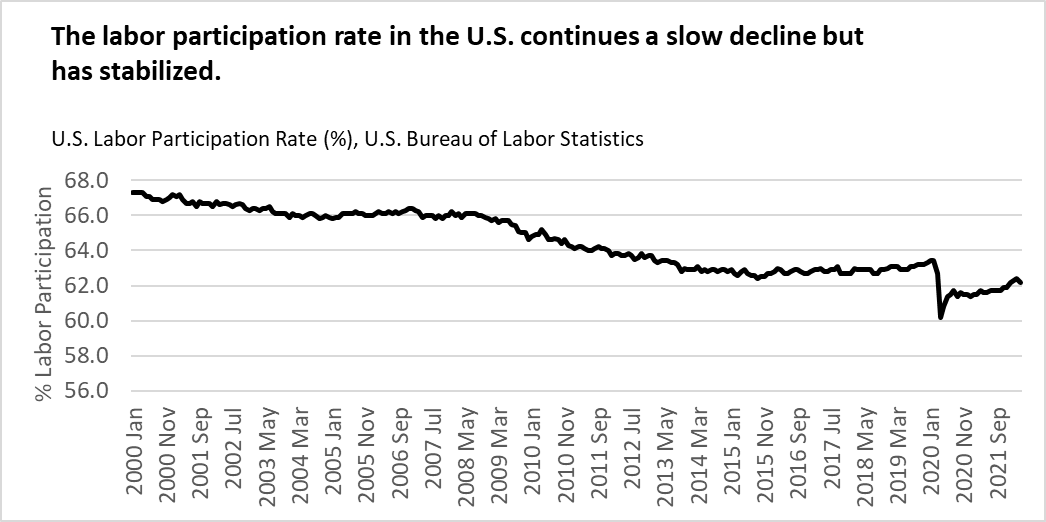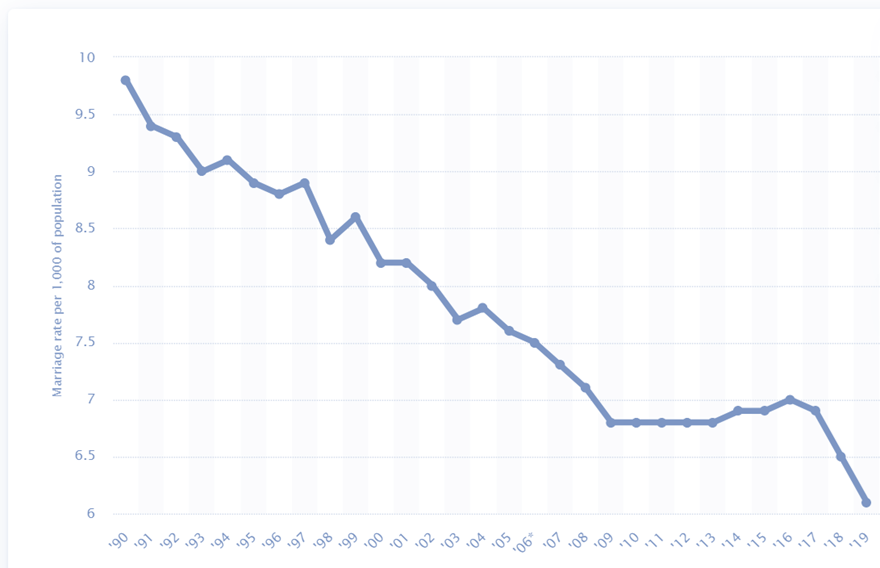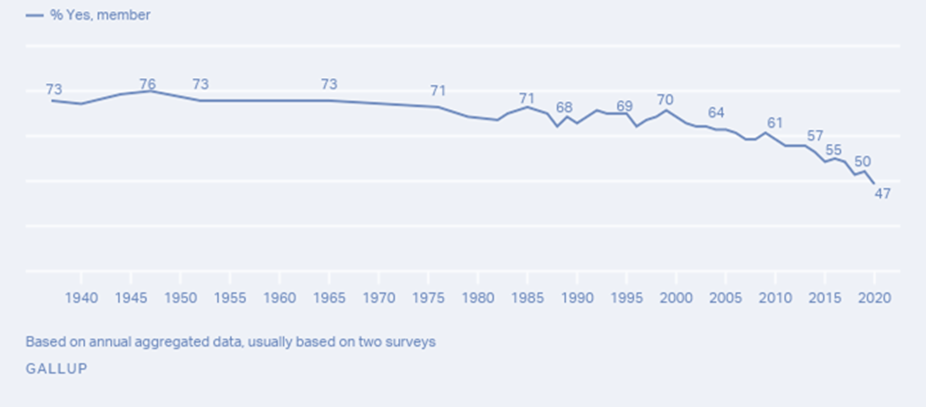This article was co-authored by David Gilbertson, VP, Ultimate Kronos Group (UKG)
What Employees Really Want and How You Can Attract and Retain Them
Having arrived at our two-year (-ish) pandemic-aversary, we’re in a situation in which hiring criteria for all jobs begins and ends with “Will show up for work.” Companies everywhere, in every industry, are complaining of labor shortages. How can that be since we have historically low unemployment at 3.6%?
It's because people are quitting all over the place! Actually, when you look at the data, you can see that this isn’t new. The number of quits has been rising every year for 10 years prior to the pandemic. In 2019, 42 million people quit their jobs; and in 2021, 47 million quit (Exhibit 1). In addition, labor participation was declining for 20 years prior to the pandemic. It’s down 0.2% from the pre-pandemic low and 1.2% off the pre-pandemic high. What’s going on is that demand is outstripping the supply of labor because of a demographic issue. (Exhibit 2)
 Exhibit 1
Exhibit 1 Exhibit 2
Exhibit 2What’s Been Causing Lower Labor Participation?
There are a number of factors that have converged to create these circumstances, and it’s not about COVID. Labor participation was already declining for 20 years prior to the pandemic. It’s down 0.2% from the pre-pandemic low and 1.2% off the pre-pandemic high. This is a demographic issue and has to do with changes and trends regarding young adults living with a parent(s); newly retired workers; childbirth and marriage rates; community engagement; and the opioid crisis.
In 2019, the trend of young adults living with parent(s) was already a reality. In 2020, the percentage of 18 to 29-year-olds went up from 47 to 52 (Exhibit 3). Baby boomer parents have accumulated wealth—with an average net worth of $1.2 million per boomer household—which means their kids can live at home and have a lot more flexibility financially. Also, right now there are 1.8 jobs for every person (almost 2:1), so they can choose whichever job they want. They can quit a bad job any day and go find another job, and they don’t have to take a job they hate.
 Exhibit 3
Exhibit 3Secondly, the number of newly retired workers has surpassed the number of new workers. For the prior 20 years, baby boomers were waiting longer and longer to retire. This came to a full stop during the pandemic when a majority decided that they were going to retire. Those people are not coming back.

Exhibit 4
In addition, a significant portion of women ages 45-54 left their jobs during the pandemic because of challenges with being able to take care of their children and parents. A majority of them have rejoined the workforce, but 1.5% are still missing. This is a key group to recruit if your company can find a way to address their flexibility needs. They’re fully trained, experienced, competent, and great at managing work-life balance. Attracting them will require putting the right labor strategies in place so that it makes it possible for them to go back to work. (Exhibit 5)

Exhibit 5
On top of this, childbirth (Exhibit 7) and marriage rates (Exhibit 6) have declined substantially over the past 30 years, and church participation went down from 70% in 2000 to 47% in 2020—all of which impact community engagement (Exhibit 8). In addition, when people become more mobile, community engagement—including engagement with an employer—drops. As people remove themselves from the community, it’s difficult to predict how they will behave.
Marriage Rate per 1,000

Exhibit 6
Birth Rates Per Woman in the U.S.

Exhibit 7
Church/Synagogue/Mosque Membership Among U.S. Adults: Are You a Member?
 Exhibit 8
Exhibit 8Adding more pressure to labor participation, 850,000 prime working-age males are out of the labor picture because of opioid use.
Where Do We Stand Now?
Some industry segments and regions have fared worse than others in terms of solving their labor shortage. Healthcare and manufacturing have faced significant hurdles in making a full recovery when it comes to finding and retaining workers. In addition, the Southeast was more heavily impacted by COVID-19 and has been slightly slower to recover. On the other hand, larger companies have recovered more significantly than smaller companies.

Exhibit 9 - Source: UKG Recovery Index
Are Employees Really Changing Jobs That Much?
According to a Microsoft study, 41% of workers said they’re looking to change jobs. In addition, according to CNBC, 43% of people who quit their jobs during the pandemic admit they were actually better off at their old job, and 1 in 5 have already boomeranged back to the company they left because of a bad culture at the new place of employment.
What Employees Want: It’s Not Just About the Money
In a job market that has continued to put the power in the hands of the employee, the long list of demands continues to grow. They want a lot:
- The ability to make a difference every day
- Feeling valued
- Structured mentoring
- Being told “Thank you” when earned
- Low barriers to employment
- Fringe benefits
- Being on a winning team
- Competitive pay
- Supporting the production of socially responsible brands
- Being a part of a diverse team
- Earned wage access
- Flexible shift schedules
- Alternative shifts from classic 8s
- The right amount of overtime
And so on, and so on….
However, Ankura’s research shows there are three top characteristics that separate companies that are rated highly by employees and companies that are not:
- Asking employees questions to better understand what they want. Employees are starving for time with their managers.
- Listening to them. Really listening. Managers need to get out of their offices more to engage with their employees and listen to what they have to say.
- Acknowledging their work by saying “Thank you.” Be authentic. Don’t give a blanket thank you to an entire group; this promotes mediocrity. Say thank you to individual employees when they have earned it and indicate what they did that you’re thanking them for; this shows you’re paying attention to what they’re working on and how they contributed.
Why Employers Will Not Be Able to Buy Their Way out of This
Why is pay ranked as #8 on the list of things employees want? And why shouldn’t your company make salaries the top concern? Employees want other types of compensation (e.g., structured mentoring, time off, decision rights, access to training, feeling valued, work-life balance, and child care), not just a decent salary. In addition, there is a discrepancy between reality and perception when it comes to salaries:

Exhibit 10
Changing the Culture to Make Employees Feel Valued
What’s your company’s mission? Does it include the belief that your employees are valuable? Do your employees feel valued?
Only 39% of employees surveyed said “the management team cares about me.” That means 61% don’t think their managers care about them. In addition, only 33% of employees believe management knows how to communicate with them. The other 67% don’t believe that. That means managers don’t know how to talk to their employees. If your company needs to recruit and retain employees, your managers need to show they care about them. This includes not acting like your leadership is smarter than your employees.
Another caveat to keep in mind: Getting a stamp for being on the “Best Places to Work” list doesn’t always translate to employee satisfaction. Companies on the list can still have problems with recruiting and retaining employees; it’s important to address the problem areas, especially since new employees will be expecting more given the placement on the list. Look at the survey to see which things your company failed at, and focus on those to make improvements.
Think of your mission statement as a guide not just to how you do business but also to how you treat employees. There are a lot of basic things you can do to move the needle when it comes to treating employees better. However, if you don’t think you have a problem, then it’s not going to work. Leadership has to believe that they have to change, not that it’s a nice thing to do.

© Copyright 2022. The views expressed herein are those of the author(s) and not necessarily the views of Ankura Consulting Group, LLC., its management, its subsidiaries, its affiliates, or its other professionals. Ankura is not a law firm and cannot provide legal advice.



